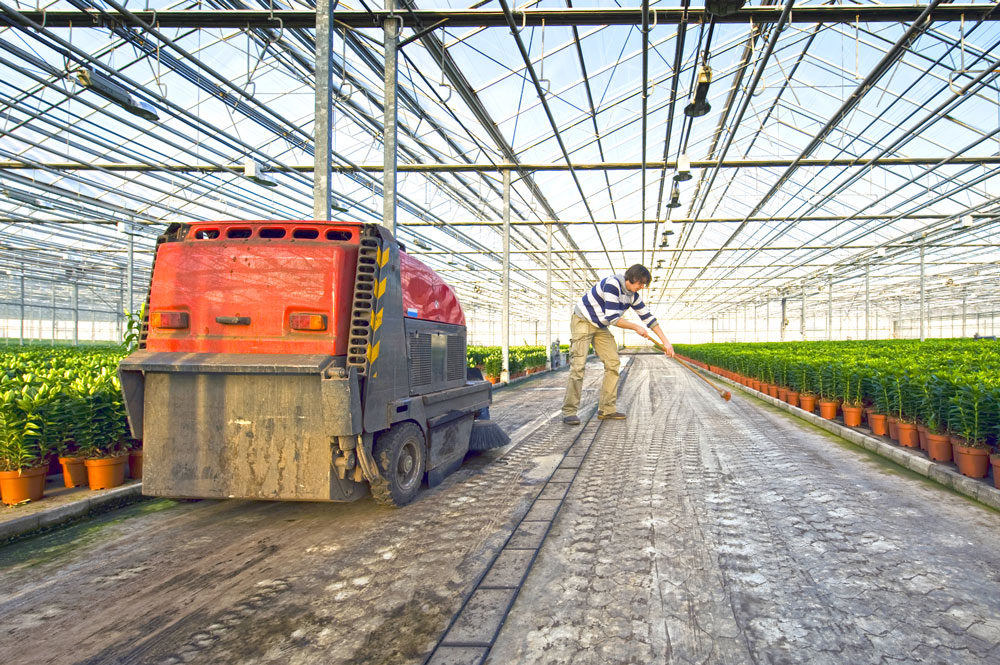Greenhouse Sanitation Can Limit Problems with Pests and Pathogens

For the greenhouse grower, the benefits of this popular production method are apparent on an almost daily basis (increased production, minimized risk, ability to grow year-round, more stability, and security). But as with anything, there are some caveats, namely that greenhouses provide the ideal conditions for pests and pathogens to thrive, which is why greenhouse sanitation is so critical.
In their report, Sanitation for Disease and Pest Management, Nathan M. Kleczewski and Daniel S. Egel of Purdue Botany and Plant Pathology state, “Greenhouse growers are often concerned about the costs of managing pests and pathogens. Proper greenhouse sanitation is a key component in reducing those costs and improving plant quality.”
Time spent on proper greenhouse sanitation practices are sometimes overlooked, but often can be considerably less expensive and stressful than having to deal with continual pesticide applications or crop losses altogether.
“Effective greenhouse sanitation requires growers and greenhouse managers to develop a “clean” mindset. Insects and pathogens are ubiquitous and may easily enter greenhouses,” the report continues. Here are a few things to remember.
Floors and Benches
These areas are a major source of pests and pathogens as they can survive for extended periods of time in soil and residue and can easily be transferred to container-grown plants. Purdue’s report stresses keeping greenhouse floors free of exposed soil or plants debris to prevent transfer. Concrete floors are optimal and should be swept and washed frequently.
While metal benches are expensive, they’re easier to sanitize as wood is porous and can house pests and Termites. Remember, water alone is not a sanitizer. There are many commercial products on the market with effective ingredients such as bleach, quaternary ammonium, hydrogen dioxide, and chlorine dioxide, which will effectively do the job. Always use protective gear and follow the instructions on the label.
Weeds
These are another direct source for pests and pathogens to reside. Make sure all weeds growing both inside and immediately outside the greenhouse are removed upon sight. Handpicking is ideal as chemicals could actually damage surrounding plants and soils.
Tools, Containers and Other Equipment
Wash tools and equipment with soapy water, as well as sanitizing using products with the ingredients mentioned above. This is one of the best ways to eliminate the spread of diseases in the greenhouse.
Reusing containers for your next crop can be a dangerous proposition as pests and pathogens could be hiding inside. It’s recommended to dispose/recycle containers after one growing season to avoid any contamination to the new plant. However, if your budget forces you to re-use containers again, make sure they are washed with soapy water, as well as sanitizing using products with the ingredients mentioned above.
Trash Bins
Trash can also harbor pests and pathogens so keep them outside of the greenhouse and make sure any discarded soil or plant material is also removed. If trash bins must be stored inside the greenhouse, make sure a tight-fitting lid is available.
Routine Schedule Cleanings
In general, thorough cleaning to sanitize your greenhouse should be done at the end of the growing season and before replanting begins. Power washing can get rid of dirt, grime, and algae, but sanitizing agents are still necessary to get rid of any residual pests or pathogens.
After cleaning, close all the vents and doors and allow the greenhouse to sit for a few days, as the hot temperatures inside can also effectively reduce pest populations and pathogen growth.
The Purdue report concludes with, “These guidelines require time and attention to detail. However, the benefits of following these practices will be evident when used effectively and consistently. A clean greenhouse leads to healthy plants, and healthy plants lead to happy growers.”
Need containers?
Browse our full line of greenhouse, nursery, cannabis, fiber and consumer containers and request free samples.
Browse Containers

 Find the Perfect Planter
Find the Perfect Planter